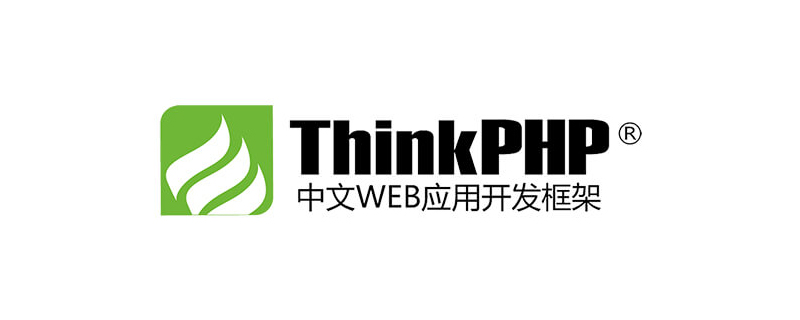In thinkphp, the function of route routing is to simplify the URL access address and make correct parsing according to the defined routing type. The purpose of routing is to simplify the path and define some rules while simplifying the path. .

The operating environment of this article: Windows 10 system, ThinkPHP version 5, Dell G3 computer.
What is the use of route routing in thinkphp
The network access address has always been mapped. Initially, it was like this, host name (computer name) =>ip address (such as LAN 192.168.1.1 )
The routing definition is to hide the real url address and use the access address to access the application (website or OA or something). It is usually defined like this: 'Access address' => 'Real address', which means It creates a mapping relationship, such as using "1" to represent going to your home, and using "0" to represent going to your colleague's home, which is the same principle. The routing rules are determined by TP. For example, the access rules of TP are: root directory/module/controller/method. We only need to define the mapping relationship, such as 'reg'=>'index/user/reg', then I only need to enter: "domain name/reg" in the browser to access "index module/user controller/reg Method" this address.
Because normally the url paths we have not processed are composed of modules/controllers/methods/parameters. If not "covered", some people will see the internal structure clearly. What will be done? When there is a certain amount of beauty in terms of aesthetics
, the URL request can be elegantly mapped to the operation method you want to perform. thinkphp's routing can make your URL address more concise and elegant
1. What is Route (routing)?
The official document defines it like this => The function of routing is to simplify URL access addresses and make correct parsing based on the defined routing type.
Manual explanation: When we usually access our ThinkPHP project according to our habits, the regular url should be written like this, (local example) http://localhost/project name/public/index. php/module name/controller name/method name
After entering a string of URLs, you will feel very desperate, (whispering) => "I just want to test a small interface that makes me type so long. A string of addresses, the address is too long to remember...". At this time, we can use routing to simplify his address, and define some rules while shortening the address.
2. Why use routing?
Some people may blurt out: To simplify the path. Of course, this is one reason, but the reason is not that simple.
Simplifying the path is a big reason, because I thought the path was too long at first and ran over to open the route. But later in the process of using it, I found that the role of Route is not limited to simplifying the path. .
We can enable the forced use of routing, so that everyone can only come in from the route I defined. This has an advantage. If you write some scripts in some controllers that you do not want to give users access to, you can fully enable them. If routing is forced to be used, users cannot access these scripts. Otherwise, if users access these scripts and the scripts sometimes modify the database, it will be more dangerous.
Also, we can define whether the entry from this path is a get operation or a post operation, so that there will be no situation like before. A controller method can be accessed from get or post. Access is very messy. Of course, some people will say that it’s no big deal if both get and post can be accessed. In fact, distinguishing these methods is more helpful for embodying the idea of Restful API.
Recommended learning: "PHP Video Tutorial"
The above is the detailed content of What is the use of route routing in thinkphp. For more information, please follow other related articles on the PHP Chinese website!
 thinkphp是不是国产框架Sep 26, 2022 pm 05:11 PM
thinkphp是不是国产框架Sep 26, 2022 pm 05:11 PMthinkphp是国产框架。ThinkPHP是一个快速、兼容而且简单的轻量级国产PHP开发框架,是为了简化企业级应用开发和敏捷WEB应用开发而诞生的。ThinkPHP从诞生以来一直秉承简洁实用的设计原则,在保持出色的性能和至简的代码的同时,也注重易用性。
 一起聊聊thinkphp6使用think-queue实现普通队列和延迟队列Apr 20, 2022 pm 01:07 PM
一起聊聊thinkphp6使用think-queue实现普通队列和延迟队列Apr 20, 2022 pm 01:07 PM本篇文章给大家带来了关于thinkphp的相关知识,其中主要介绍了关于使用think-queue来实现普通队列和延迟队列的相关内容,think-queue是thinkphp官方提供的一个消息队列服务,下面一起来看一下,希望对大家有帮助。
 thinkphp的mvc分别指什么Jun 21, 2022 am 11:11 AM
thinkphp的mvc分别指什么Jun 21, 2022 am 11:11 AMthinkphp基于的mvc分别是指:1、m是model的缩写,表示模型,用于数据处理;2、v是view的缩写,表示视图,由View类和模板文件组成;3、c是controller的缩写,表示控制器,用于逻辑处理。mvc设计模式是一种编程思想,是一种将应用程序的逻辑层和表现层进行分离的方法。
 thinkphp扩展插件有哪些Jun 13, 2022 pm 05:45 PM
thinkphp扩展插件有哪些Jun 13, 2022 pm 05:45 PMthinkphp扩展有:1、think-migration,是一种数据库迁移工具;2、think-orm,是一种ORM类库扩展;3、think-oracle,是一种Oracle驱动扩展;4、think-mongo,一种MongoDb扩展;5、think-soar,一种SQL语句优化扩展;6、porter,一种数据库管理工具;7、tp-jwt-auth,一个jwt身份验证扩展包。
 实例详解thinkphp6使用jwt认证Jun 24, 2022 pm 12:57 PM
实例详解thinkphp6使用jwt认证Jun 24, 2022 pm 12:57 PM本篇文章给大家带来了关于thinkphp的相关知识,其中主要介绍了使用jwt认证的问题,下面一起来看一下,希望对大家有帮助。
 一文教你ThinkPHP使用think-queue实现redis消息队列Jun 28, 2022 pm 03:33 PM
一文教你ThinkPHP使用think-queue实现redis消息队列Jun 28, 2022 pm 03:33 PM本篇文章给大家带来了关于ThinkPHP的相关知识,其中主要整理了使用think-queue实现redis消息队列的相关问题,下面一起来看一下,希望对大家有帮助。
 thinkphp 怎么查询库是否存在Dec 05, 2022 am 09:40 AM
thinkphp 怎么查询库是否存在Dec 05, 2022 am 09:40 AMthinkphp查询库是否存在的方法:1、打开相应的tp文件;2、通过“ $isTable=db()->query('SHOW TABLES LIKE '."'".$data['table_name']."'");if($isTable){...}else{...}”方式验证表是否存在即可。
 thinkphp3.2怎么关闭调试模式Apr 25, 2022 am 10:13 AM
thinkphp3.2怎么关闭调试模式Apr 25, 2022 am 10:13 AM在thinkphp3.2中,可以利用define关闭调试模式,该标签用于变量和常量的定义,将入口文件中定义调试模式设为FALSE即可,语法为“define('APP_DEBUG', false);”;开启调试模式将参数值设置为true即可。


Hot AI Tools

Undresser.AI Undress
AI-powered app for creating realistic nude photos

AI Clothes Remover
Online AI tool for removing clothes from photos.

Undress AI Tool
Undress images for free

Clothoff.io
AI clothes remover

AI Hentai Generator
Generate AI Hentai for free.

Hot Article

Hot Tools

Dreamweaver Mac version
Visual web development tools

mPDF
mPDF is a PHP library that can generate PDF files from UTF-8 encoded HTML. The original author, Ian Back, wrote mPDF to output PDF files "on the fly" from his website and handle different languages. It is slower than original scripts like HTML2FPDF and produces larger files when using Unicode fonts, but supports CSS styles etc. and has a lot of enhancements. Supports almost all languages, including RTL (Arabic and Hebrew) and CJK (Chinese, Japanese and Korean). Supports nested block-level elements (such as P, DIV),

PhpStorm Mac version
The latest (2018.2.1) professional PHP integrated development tool

SublimeText3 Chinese version
Chinese version, very easy to use

MinGW - Minimalist GNU for Windows
This project is in the process of being migrated to osdn.net/projects/mingw, you can continue to follow us there. MinGW: A native Windows port of the GNU Compiler Collection (GCC), freely distributable import libraries and header files for building native Windows applications; includes extensions to the MSVC runtime to support C99 functionality. All MinGW software can run on 64-bit Windows platforms.







